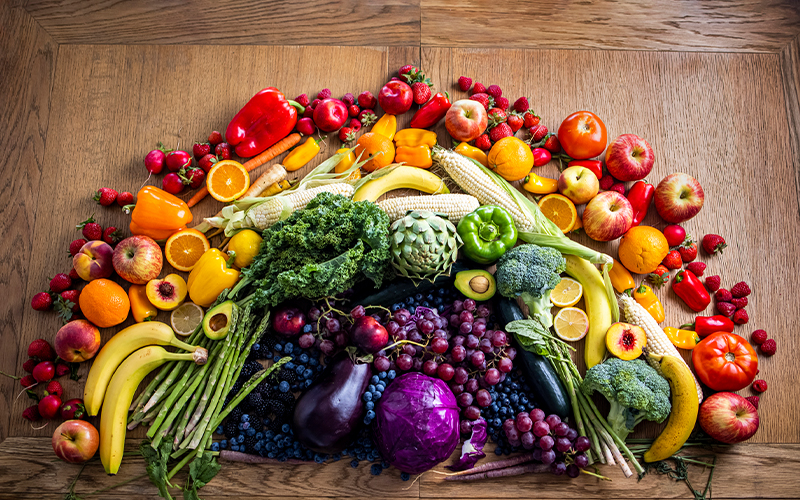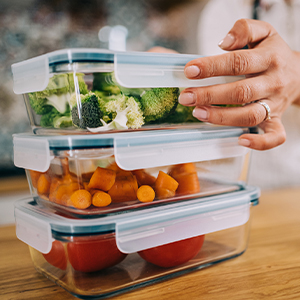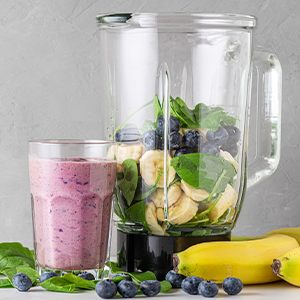How to Eat More Fruits & Veggies

Experts recommend 4-5 servings of fruit and vegetables daily. Unfortunately, Americans aren’t adventurous eaters of this food group. In fact, the potato – whether baked, fried, or chipped – is the most commonly consumed vegetable in the U.S.
Is your plate as colorful as it should be?
The Unique Benefits of Eating the Rainbow
Fruits and vegetables are rich in health-promoting vitamins, minerals, antioxidants, and fiber that other food groups may lack. Eating the recommended serving each day can help:
- Lower your risk of chronic diseases and certain types of cancer
- Fill you up and feel more satisfied between meals
- Reduce cravings for sugar and processed foods
- Promote daily bowel movements
- Maintain a healthy weight
- Regulate blood sugar
- Help beat prediabetes and manage type 2 diabetes
But why is it so important to eat your greens – and yellows, oranges, and purples too?
The rich variety gives this food group its best feature: its nutritional content. Eating many types of vegetables and fruits can give your body the healthy boost it needs.
"The nutrients in fruit and vegetables vary based on the type and color, so to give your body the full spectrum of benefits, eating the rainbow is key,” shares Vanessa Mihalick, Registered Dietitian for Munson Healthcare.
How to Eat More Vegetables and Fruits

Most adults are not getting the recommended servings per day. This can be due to many factors, such as cost, time, convenience, taste, availability, and growing season.
1) Savor the season
Fresh vegetables and fruits often cost less (and they’re tastier) when eaten during their harvesting time. Eating seasonally also naturally gives your body variety throughout the year.
2) Don’t dismiss frozen or canned vegetables
Many people assume that packaged vegetables and fruits aren't as nutrient-dense. But you might be surprised at the many myths about fresh vs frozen and canned produce. In fact, frozen and canned fruit and vegetables can be just as good as eating them fresh! If you opt for canned varieties, Mihalick recommends scanning the labels for for “low sodium” and “packed in water” (vs syrup or sugar).
“If you’re having a hard time finding them, you can rinse the veggies or fruit in a colander before eating to wash away some of the excess salt or sugar,” Mihalick shares.
3) Prep before you refrigerate
Make it a habit to wash and slice your veggies and fruits when you get home from the grocery store. Turn up the fun by enjoying some music or a podcast – or ask a loved one to help. Pre-sliced produce makes meal planning easier, and you’re more likely to remember to eat it when it’s not buried in a bag in the produce drawer. Move your fruits and veggies to the front of the fridge so their rich colors pop out at you as a reminder.
4) Make veggies the star of your meal
Start with one meal a day that features vegetables as the main entrée. A stir-fry, hearty salad, or soup is a good way to feature many different vegetables. Try this fresh and crunchy apple carrot salad, a creamy zucchini soup, or search our blog for more healthful and delicious recipes.

5) Retry varieties you disliked as a kid
Did veggies like mushrooms or cabbage go cold on your plate in your younger years? They might taste better to you now!
“Our taste buds can change as we age. You may find that some foods you rejected as a kid or young adult are more enjoyable now,” Mihalick says.
6) Don’t give up
Adding more produce – especially the veggies – may be more challenging in the beginning. Especially if you’re not used to eating them. Adding more vegetables can feel like adding exercise – strange and even unpleasant. Start where you can and give yourself time.
“Start with a small goal, such as eating one serving of fruit and one serving of vegetables daily,” shares Mihalick. “Once you feel like eating one serving of each daily isn’t as challenging, bump it up to two per day of each.”
Ways to Sneak in More Veggies

Nutritional experts recommend that adults eat 2.5 to 3 cups of vegetables every day. Most adults fall far short of this goal. Try these expert tips so you can reach your daily requirement.
Blend them in a smoothie. Frozen vegetables especially can add more texture without the pungent taste.
Top with a healthy fat. Did you know that fat provides us with energy and helps our bodies absorb certain vitamins? Sprinkling some olive oil, sea salt, and pepper can make a big difference for your palate.
Experiment with new kinds! The usual suspects are great – but there may be other varieties you don’t even know you’d enjoy. Choose a different vegetable every time you go to the grocery store. You might even consider adding “new vegetables” to your shopping list! Trying new veggies can expand your palate and your meal planning.
Change up the way you prepare them. You might enjoy fruits and veggies prepared or seasoned a different way. For example, try roasting or sautéing your Brussels sprouts versus boiling. And you might change your mind about broccoli when blended in this zesty sauce.
Need more inspiration?
Check out our popular recipes here for more ideas on how to prepare your fruits and vegetables. Remember to have fun!